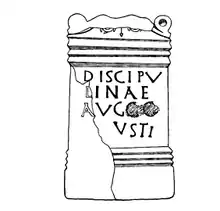Susanna Maria Appleby | |
|---|---|
| Born | Susanna Maria Gilpin 1689 |
| Died | 1769 |
| Nationality | British |
| Spouse | Joseph Dacre Appleby |
| Parents |
|
| Relatives | Richard Gilpin (grandfather) |
Susanna Maria Appleby (born Gilpin; 1689–1769) was a British antiquarian who is principally known for excavating a Roman bath house north east of Camboglanna, Castlesteads Roman Fort, near Hadrian's Wall in 1741.[1]
Life
Appleby was born in 1689, as Susanna Maria Gilpin, the daughter of William Gilpin (1657–1724) at Scaleby Castle, Cumberland. Her grandfather was Richard Gilpin, a prominent nonconformist minister and physician while her father was a minister who became Recorder of Carlisle in 1718. Appleby's mother was Mary, daughter of Henry Fletcher of Tallantire, Cumberland. Appleby married Joseph Dacre Appleby and had eight children, three of her sons died young.[2][3] They lived at Kirklevington Hall in Kirklevington.[3] Appleby died in 1769.
Excavations

Joseph Dacre Appleby owned the land on which Camboglanna was situated, and employed men to dig at the site for stone.[4] After his death, in 1741, Susanna Appleby excavated a Roman bath house, in woodland north east of Camboglanna (Castlesteads Roman Fort).[1] In William Hutchinson's 1794 volume on the history of the county of Cumberland, he publishes a letter written by the antiquarian Roger Gale with Appleby's description of the site.[3] The bath house was discovered in woodland to the north east of the fort, where remains of the hypocaust system and paved flooring could still be seen in rooms of the bath house.[5] An altar from the site was removed and carried to Appleby's house in 1741.[6][5] In the same year, the antiquarian George Smith (1700–1773) visited the site and drew a plan of the site and inscriptions, later published in The Gentleman's Magazine.[4] In his letters to The Gentleman's Magazine, Smith described how Appleby had found a clay flooring with pedestals, and commented that:
Mrs Appleby, who deserves to be gratefully remember'd by all Lovers of Antiquity, took great Pains to preserve what she cou'd of those valuable Remains of the Antients.[4]
Appleby's early work and observations at the site of Camboglanna in the 1740s are significant due to the later destruction of the fort during the construction of Castlesteads house and gardens in 1791.[7][8] Eric Birley, in his 1961 work on Hadrian's Wall, described Appleby as "the earliest female antiquary of whom we have a record in the Wall region."[9]
References
- 1 2 England, Historic. "The Roman bath house to the north east of Castlesteads Roman fort in wall mile 56, Walton – 1015924 | Historic England". historicengland.org.uk. Retrieved 25 June 2019.
- ↑ Nicolson, Joseph; Burn, Richard; Nicolson, William; Scott, Daniel; Hornyold-Strickland, Henry (1777). The history and antiquities of the counties of Westmorland and Cumberland. Printed for W. Strahan.
- 1 2 3 Hutchinson, William (1794). The History of the County of Cumberland: And Some Places Adjacent, from the Earliest Accounts to the Present Time: Comprehending the Local History of the County; Its Antiquities, the Origin, Genealogy, and Present State of the Principal Families, with Biographical Notes; Its Mines, Minerals, and Plants, with Other Curiosities, Either of Nature Or of Art ... F. Jollie. p. 568.
Susanna Maria Appleby.
- 1 2 3 Hingley, Richard (4 October 2012). Hadrian's Wall: A Life. OUP Oxford. pp. 114–5. ISBN 9780199641413.
- 1 2 "Old Cumbria Gazetteer, roman fort, Castlesteads". www.geog.port.ac.uk. Retrieved 29 June 2019.
- ↑ RIB 1978 Altar dedicated to the Discipline of the Emperor(s). https://romaninscriptionsofbritain.org/inscriptions/1978#RIB
- ↑ Biggins, J. A.; Taylor, D. J. A. (2007). "The Roman Fort at Castlesteads, Cumbria: A Geophysical Survey of the Vicus". Trans. C. & W. Soc. VII: 15–30.
- ↑ England, Historic. "Castlesteads Roman fort and the vallum between the track to the east of Castlesteads fort and the Cam Beck in the west, Irthington – 1010985 | Historic England". historicengland.org.uk. Retrieved 29 June 2019.
- ↑ Birley, Eric (1961). Research on Hadrian's Wall. T. Wilson. p. 204.